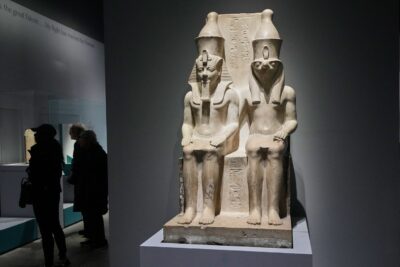Met Museum’s first Egypt show in over a decade brings ancient gods and goddesses to life
By Canadian Press on October 18, 2025.

NEW YORK (AP) — The powerful gods of ancient Egypt are having a get-together on Manhattan’s Upper East Side.
That would be at the Metropolitan Museum of Art. It’s been more than a decade since the museum’s last big Egypt show, so “Divine Egypt” — a lavish exploration of how ancient Egyptians depicted their gods — is a major event, as evidenced by the crowds packing the show since its Oct. 12 opening.
After all, few things excite the museum-going public like ancient Egypt, notes Diana Craig Patch, the Met’s curator of Egyptian art.
“It’s the first ancient culture that you learn in school,” says Patch. “Pyramids, mummies, the great tomb of Tutankhamun … they’re in our popular culture, books, films and now video games.”
But Patch hopes visitors will learn something deeper from “Divine Egypt,” which explores how the gods were portrayed by Egyptians both royal and common, and not only in temples where only kings or priests could go, but in daily worship by ordinary people.
Ancient Egyptian civilization lasted some 3,000 years; the show, which runs into January, covers all periods and features over 200 objects, from huge limestone statues to tiny golden figurines. It includes 140 works from the Met’s collection, as well as others lent by museums across the globe.
“The divine landscape of ancient Egypt is full of gods — actually 1,500 if you count all of them,” said Patch, leading The Associated Press on a tour last week. The show focuses on 25 main deities.
Even pared down to 25, the research was daunting. The material and the textual information in Egyptology is fragmentary. What’s more, the Egyptians kept bringing in new gods, or giving established gods new roles. “And so that makes it a very complex, but fascinating landscape,” Patch says.
One aim is to show visitors that all of these images concern “how ancient Egyptians related to their world. Those gods were how they solved problems of life, death, and meaning — problems that we’re still trying to solve today.”
Some highlights:
Opening greetings from Amun-Re and a king named Tut
You’d think that the boy king Tutankhamun, aka King Tut, would be the star of any party, given the astounding riches from his tomb the world has come to know. But in a sculpture that first greets visitors, from the Louvre in Paris, the solar god Amun-Re sits on a throne, presenting the much smaller pharaoh beneath his knees — or rather, protecting him — with hands resting on the small shoulders. The god is identified by his feathered crown, curled beard, divine kilt and jewelry — and is definitely the main attraction. Amun-Re was worshipped at the Karnak temple complex; the presence of Re in his name links him closely to the sun.
Expressing the divine: Horus and Hathor
The first of five galleries, “Expressing the Divine” focuses on two main deities, the god Horus and goddess Hathor. Horus is always represented as a falcon with a double crown, which signifies he is the king of Egypt and linked to the living king. But Hathor, who represents fertility, music and defense, among other things, takes many forms, including a cow, an emblem, a lion-headed figure or a cobra. In one statue here, she wears cow horns and a sun disc.
“So these are two main ways gods are represented: sometimes with lots of roles, sometimes with only one,” Patch says.
Ruling the cosmos: the sun god Re
This gallery looks at the all-important Re, whose domains are the sun, creation, life and rebirth. Re often merges form with other deities. “Re rules the world — he’s the source of light and warmth,” Patch says.
He’s presented in this room as a giant scarab beetle. “That’s his morning aspect,” Patch says. “He’s seen as a beetle who takes the sun out from the underworld and pushes it up into the sky.”
Also here is a vivid painted relief of the goddess Maat, from the Valley of the Kings in Thebes (modern Luxor). She embodies truth, justice and social and political order. Patch notes: “The best way we translate it today is rightness. She stands for the world in rightness, the way it should work.”
Creating the world: multiple mythologies of creation
This gallery explores five myths surrounding the creation of the world and its inhabitants.
“This is one of the things that I hope people begin to take away: that Egyptians had multiple ways of dealing with things,” Patch says of the competing myths. “I find that fascinating. They overlapped.”
She’s standing beside a huge statue of the god Min in limestone — a headless representation of a hard-to-define god associated with vegetation, agricultural fertility and minerals.
Coping with life: a statuette in solid gold
Only kings and priests could access state temples to worship their gods. What were regular folks to do?
Patch explains: “At festivals, the god came out of the temple on a sacred barque (sailing vessel), and people could commune with that image in the streets, and ask him or her questions.”
In this room, curators have arranged a set of objects as if on a barque. At the top and center: a gleaming, solid gold statuette of Amun, which the Met purchased in 1926 from the collection of Lord Carnarvon, who was involved in the 1922 discovery of Tut’s tomb.
Overcoming death: the gods of the afterlife
Some of the most striking art connected to Egyptian gods is about death and the afterlife. “Overcoming death is something that kings and non-royals alike had to deal with,” says Patch.
The gods in this section include Anubis, who embalms the deceased and leads them to the afterlife; Isis and Nephthys, the sisters of Osiris, who mourn and protect the dead; and Osiris, judge and ruler of the afterlife.
This gallery houses the show’s signature object: a stunning statuette, on loan from the Louvre, depicting the triad of Osiris, Isis and Horus. Made of gold inlaid with lapis lazuli, it shows the shrouded Osiris, falcon-headed Horus, and Isis in a sun disc and horns. The gold represents the skin of the gods, the lapis their hair.
Although this last section is about overcoming death, “I think you will have seen that most of the exhibition is about life,” Patch notes. “And that is what all of these deities were about. Even in overcoming death, it was about living forever.”
___
Associated Press video journalist Ted Shaffrey contributed to this report.
Jocelyn Noveck, The Associated Press
-37

